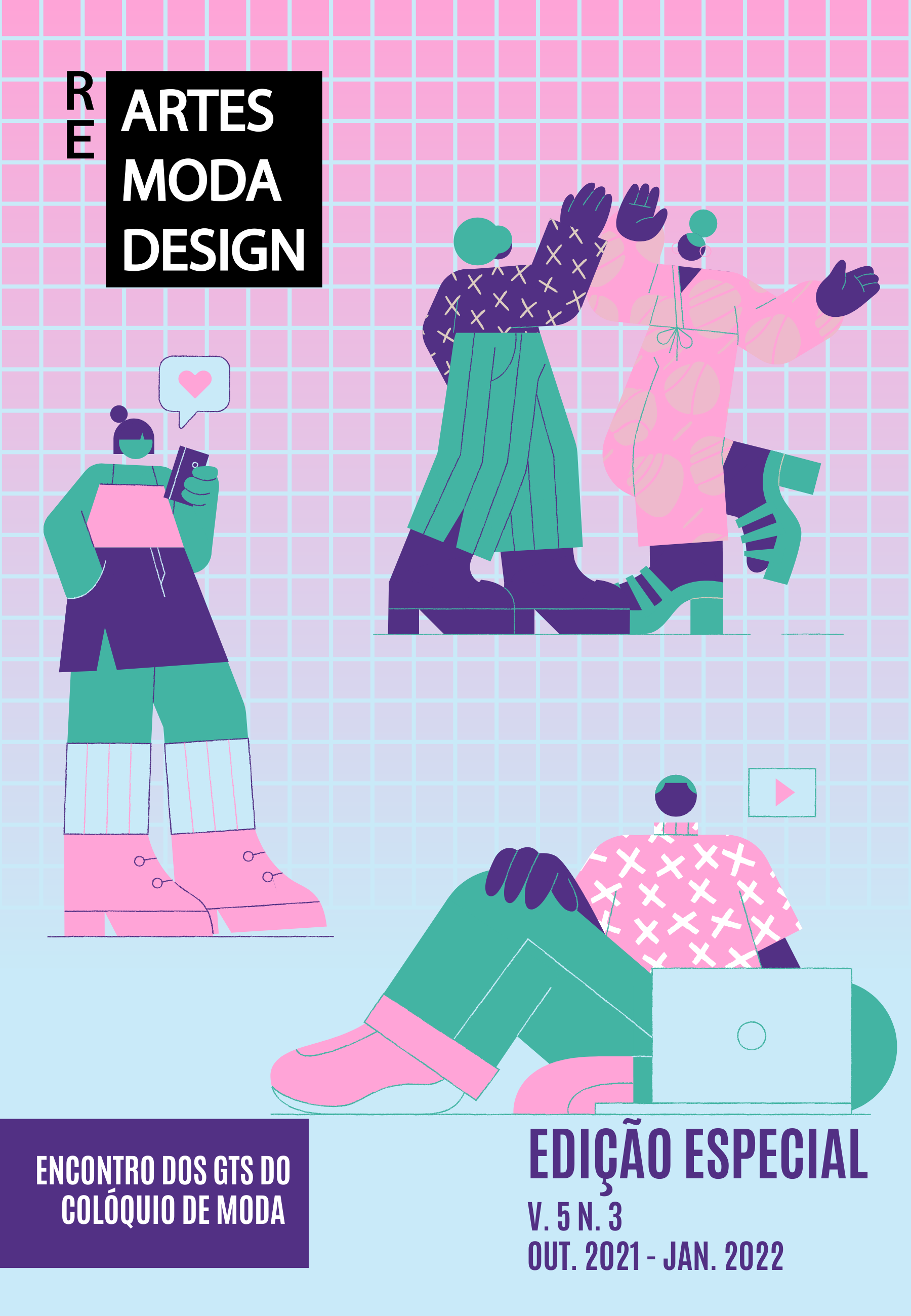À l’Orient: fantasy and oriental idealization in Paris in the 1780’s
DOI:
https://doi.org/10.5965/25944630532021107Keywords:
Fashion History, 18th century, OrientalismAbstract
The present paper analyzes the emergence of fashion trends in Paris during the 1780s, whose self-proclaimed reference and inspiration came from the Orient. More fantasy and idealization of what the french conceived as oriental, these tendencies had little or no connection with what was used by the populations of the different localities and regions to which they referred, whether from Circasia, Turkey, China, Zion, Conchinchina or India. To this purpose, we examined the writings and illustrations of the magazines Cabinet des modes and Magasin des modes Nouvelles, along with reports in newspapers and anecdotaires from the period, in addition with memories of some well-known individuals of the late 18th century France. We do not see these trends as representations of a supposed “reality” of dress and clothing, but as objects that expose an intricate network of social exchange between the fashion sector that was being consolidated in Paris and political-diplomatic events and notions of exotic, sensual and unusual. The conclusion of the study is that the “orientalist” trends demonstrate the capacity of the Parisian fashion sector to assimilate current events and varied cultural elements into its operation. More than that, these trends emphasize the ability to use and dispose of cultural references, manipulate them for European tastes and needs and transform them into something completely new and that had little, if any, resemblance to the original inspiration and reality, even though they were widely publicized, sold and consumed as related to them.
Downloads
References
Cabinet des Modes. Disponível: <https://gallica.bnf.fr/ark:/12148/cb327349107/date> Acessado em: maio de 2019.
D’HÉZECQUES, Félix. Page à la cour de Louis XVI: souvenirs du comte d’Hézecques. Paris: Tallandier, 1987.
FREUDSTEIN, Henriette Louise de Waldner. Mémoires de la Baronne d’Oberkirch. 1869. Disponível em: <https://gallica.bnf.fr/ark:/12148/bpt6k2048423> Acessado em: maio de 2019
Gallerie des modes. Disponível em: <https://collections.mfa.org/search/objects/*/gallerie%20 des%20modes%20> Acessado em: maio de 2019.
Magasin des modes nouvelles. Disponível em: <https://gallica.bnf.fr/ark:/12148/cb32896302v/ date> Acessado em: maio de 2019
Mercure Galant. Disponível em: <https://gallica.bnf.fr/ark:/12148/cb40216887k/date> Acessado em: maio de 2019
MERCIER, Louis-Sébastie. Le Tableau de Paris. (ed. org. Jean-Claude Bonnet). Paris: Mercure de France, 1994.
VIGÉE LEBRUN, Elisabeth. Memoirs of Madame Vigée LeBrun with numerous reproductions of paintings by the authoress. Londres: Grant Richards, 1904.
Bibliografia
DELPIERRE, Madeleine. Se vêtir au XVIIIe siècle. Paris: Société Nouvelle Adam Biro, 1996.
HEINICH, Nathalie. Du peintre à l’artiste: artisans et académiciens à l’âge classique. Paris: Edi-tions de Minuit, 1993.
LANDES, Joan B. Women and the public sphere in the age of the French Revolution. Ithaca: Cornell University Press, 1988
LILTI, Antoine. Le monde des salons: sociabilité et mondanité à Paris au XVIIIe siècle. Paris: Fayrad, 2005.
LIPOVETSKY, Gilles. L’Empire de l’éphémère: la mode et son destin dans les sociétés modernes. Paris: Gallimard, 1987.
MARTIN, Meredith. Tipu Sultan’s Ambassadors at Saint-Cloud: indomania and anglophobia in pre-revolutionary Paris. West 86th: A Journal of Decorative Arts, Design History and Material Culture. Vol. 21, No 1, Spring-Summer 2014, p. 37-68. Disponível em: <https://www.jstor.org/stable/10.1086/6778 68?origin=JSTOR-pdf>
MARTIN, Richard. KODA, Harold. Orientalism: visions of the East in the western dress. Catá
OUTRAM, Dorinda. The body and the French Revolution: sex, class and political culture. Lon-dres: Yale University Press, 1989.
RIBEIRO, Aileen. Dress and morality. Londres: B. T. Batsford, 1986.
______________. Fashion in the French Revolution. Londres: Batsford ltd., 1988.
ROCHE, Daniel. A cultura das aparências: uma história da indumentária (séculos XVII-XVIII). São Paulo: Editora SENAC, 2007.
______________. História das coisas banais: nascimento do consumo nas sociedades dos séculos XVII ao XIX. Rio de Janeiro: Rocco, 1999.
ROOKMAKER, L. C. The zoological exploration of Southern Africa, 1650-1790. Roterdã: A. A. Balkema, 1989.
RIBEIRO, Aileen. Turquerie: turkish dress and English fashion in the Eighteenth century. Revue Connoisseur, maio de 1979.
SAID, Edward W. Orientalismo: o Oriente como invenção do Ocidente. São Paulo: Cia. Das Le-tras, 2007. logo de Exposição. Nova York: Metropolitan Museum of Art (MET), 1994.
Downloads
Published
How to Cite
Issue
Section
License
Copyright (c) 2021 Felipe Goebel

This work is licensed under a Creative Commons Attribution 4.0 International License.
- Authors retain copyright and grant the journal the right of first publication, with work simultaneously licensed under the Creative Commons Attribution 4.0 International License, which allows for:
1. Share — copy and redistribute the material in any medium or format for any purpose, even commercially.
2. Adapt — remix, transform, and build upon the material for any purpose, even commercially.
The licensor cannot revoke these freedoms as long as you follow the license terms.Under the following terms:
1. Attribution — You must give appropriate credit, provide a link to the license, and indicate if changes were made. You may do so in any reasonable manner, but not in any way that suggests the licensor endorses you or your use.
2. No additional restrictions — You may not apply legal terms or technological measures that legally restrict others from doing anything the license permits. -
Plagiarism, in all its forms, constitutes unethical publication behavior and is unacceptable. This magazine uses iThenticate similarity control software.






